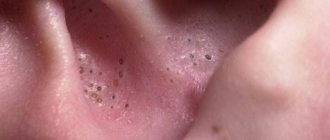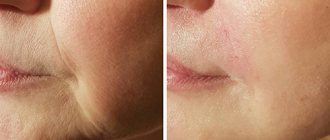A hanging mole is a type of nevus, which is a neoplasm on a stalk. Neoplasms arise as a result of impaired synthesis of the melanin pigment and are localized in problem areas: armpits, neck, face. You can get rid of hanging moles at home if there are no contraindications. If the nevus does not cause any inconvenience, it is not necessary to remove it.
What are moles? What are they?
To answer this question, you must first clarify what we mean by the word “mole.” An ordinary person can easily find several types of skin formations. Brown, red, flesh-colored - all these can be called moles. In fact, the World Health Organization (WHO) classification of benign skin lesions includes about 150 names. And all this diversity can also be called moles. Read a little more about the most common types of moles here.
As we said above, there are a huge number of types of moles. Today we will talk about those that are most common and, theoretically, can pose the greatest danger - brown and flesh-colored moles.
Pharmacy ointments
There are the following ointments that can be bought at a pharmacy to remove nevi:
- Malavit. A biologically active preparation based on mumiyo, Altai herbs and minerals with beneficial acids. The product is applied by applying it to a cotton pad and attaching it to the site of the nevus. Since the drug is very concentrated, it must be used at least 2 times every 48 hours.
- Stefalin. Made from natural herbs. Application is made to the immediate location of the formation, avoiding the area around it. Tip: The tissue surrounding the nevus can be protected with a medical plaster.
- Cryopharma. The product works on the basis of quick freezing. Apply only at the location of the formation. Due to the fact that it is very aggressive on the skin, it is forbidden to use it in delicate places.
- Collomak. Suitable for removing small moles. A weakly active drug that requires repeated application throughout the day. Use no more than 4 days in a row.
If there are doubts about whether to remove an unwanted mole on the face with pharmaceutical preparations, the decision is made based on the composition of the product and the degree of its concentration.
Brown moles
Such moles are a cluster of nevus cells. These cells are very similar to melanocytes and, like them, produce the pigment melanin. This pigment is brown in color, which makes our skin darker if there is a lot of it and lighter if there is not enough of it. Its production also increases after prolonged exposure to the sun.
Melanocytes and nevus cells
Melanocytes and nevus cells have certain differences, which we will not delve into. Let’s just note that brown moles most often consist of nevus cells. It is nevus cells that can turn into melanoma cells - one of the most malignant human tumors (more about it here)
Precautionary measures
Before removing a mole, you need to make sure that there are no contraindications to this operation. It is important to understand that the best way to protect yourself before upcoming treatment is to:
- visit a dermatologist;
- analyze the tumor for malignancy;
- Consult a doctor on how to take precautions.
If the mole is shallow and small, it is quite possible to remove it yourself. Otherwise, experts recommend surgical, laser or chemical removal. This operation is carried out within 30 minutes and is practically painless, which cannot be said about traditional methods.
If there are any doubts about whether or not to use a home remedy for the face, experts recommend only the medical option in order to avoid unwanted complications.
However, if, despite the danger, a person still decides to use home methods, it would be wise to find out what methods exist and which of them are suitable for a particular situation.
Why can mole removal be dangerous?
If you have already read about moles on the Internet, then you have probably already found information that “after removing moles, you can die from cancer.” I discuss this topic in detail in this article. Now I will say that such cases really do happen. This happens when a doctor removes a malignant tumor, which he considered an ordinary mole, and does not send it for histological examination. After this, indeed, melanoma can very quickly develop at the site of removal and this can cause death.
Contraindications for removal
- exacerbation of chronic diseases;
- infectious diseases;
- dermatoses;
- the presence of open wounds, abrasions, and other pigment spots near the tumor;
- the mole is at the stage of transformation into melanoma.
Timely consultation with a doctor and correct diagnosis will help prevent the neoplasm from becoming malignant. If there is no effect as a result of using traditional methods, the doctor will suggest hardware procedures: radio wave method, cryodestruction, laser exposure, removal with high-frequency electric current.
Reasons for removing moles
In my opinion, there are 4 reasons to remove moles:
- The mole raises doubts about its benign quality among the oncologist. In this situation, we will not be talking about removing a mole, but about a biopsy of a possible malignant tumor. Subsequent histological examination will show whether a larger operation is needed or not.
- The mole is subject to regular trauma. This can happen when playing sports, shaving, during work, when a mole is located on the belt or bra line, as well as in a hairdresser. Regular traumatization of a mole, especially to the point of bleeding, may be one of the risk factors for the development of melanoma.
- A mole causes a cosmetic defect. No explanation needed here. The issue of beauty is very individual for each person and there are no clear rules here.
- A mole causes obsessive thoughts about its transformation into cancer or melanoma (oncophobia). As a rule, this happens after a long time of independently studying the Internet on the topic of melanoma and skin cancer. Sleep and appetite are disturbed, neurosis sets in, because if you want, you can find confirmation of anything on the Internet. Not only that “this mole I have is definitely melanoma,” but also that “Lenin is a mushroom.” In this situation, removal of the mole is necessary only to restore lost psychological comfort.
In the latter case, it is important to combine deletion with stopping independent study of the World Wide Web on the topic of skin cancer and melanoma.
Is it possible to remove a hanging mole yourself?
In addition, occasionally, but it still happens that moles can degenerate into a malignant tumor, which is caused by the action of certain negative factors, such as mechanical damage, excessive exposure to ultraviolet radiation. In such cases, the risk of developing a dangerous malignant tumor – melanoma – increases. However, most often moles bother their owners for another reason, namely from an aesthetic point of view. Hanging moles look especially unpleasant. This is a type of benign tumor that looks like small papillae, which often looks extremely unattractive. Many people are interested in whether it is possible to remove a hanging mole on their own, and how to do it as effectively and safely as possible?
A hanging mole can be extremely unsightly and can significantly spoil the appearance, especially if it is located on an open area of the body. Its surface is uneven, like cauliflower, and its color can vary from flesh-colored to dark brown. What is most unpleasant is that quite often hanging moles appear not one by one, but in a whole scattering. This fact often forces people to look for ways to remove this cosmetic defect, and many do not even think about whether it is even possible to effectively remove an unsightly hanging mole on their own, for example, by tearing it off or trying to cut it off with something.
Of course, from a medical point of view, attempts to independently remove a hanging mole, especially in such a barbaric way, are considered extremely undesirable and simply dangerous to health. In principle, if this skin formation does not interfere with its owner in any way, it can be completely left alone and not paid attention to it; it is unlikely to cause any concern in the future. However, the favorite places for hanging moles to be localized are areas of the body such as the armpits, neck, and groin area, which causes a certain danger, in particular, it can be accidentally shaved off when removing hair in these places. Thus, trying to eliminate this defect is a rather pressing issue, so many people try to independently remove a hanging mole located in an inconvenient place.
Despite the fact that such neoplasms have a certain risk of degenerating into a malignant tumor, hanging moles degenerate extremely rarely and the risk increases significantly only in cases where the mole is damaged.
Hanging mole in the groin
. As a rule, it is particularly inconvenient only for those who remove hair in this area by shaving. If it is accidentally damaged, the mole must be treated with brilliant green or hydrogen peroxide.
Hanging mole on the neck
. Such localization of a hanging mole is especially dangerous for men who have to shave regularly; there is a significant risk of damage or complete cutting off of the mole. In addition, the neck is more exposed to sunlight than the groin or armpits, which can have an extremely negative impact on the condition of the tumor, and there is an increased risk of its degeneration into melanoma. A possible option for protecting a hanging mole from accidental mechanical damage is to seal it with a piece of plaster while shaving or during prolonged exposure to the sun.
Hanging mole under the armpits.
They cause inconvenience in cases where you have to shave hair in this area of the body, but damage to moles in the armpits is especially dangerous because there are numerous sweat glands located here, which contributes to the increased development of various microorganisms.
Regardless of the location of hanging moles on the human body, removing them is not necessary, but it is also not contraindicated, under one, main condition - this must be done after consultation with a doctor and in a specialized clinic. Of course, similar services are available today in various beauty salons, but to be more confident in a favorable outcome, it is better to contact a doctor. In doctors' offices, this procedure is not only done safely and effectively, but also quite quickly and takes only a few minutes. There are many modern methods for removing hanging moles today: freezing with liquid nitrogen, removal using electric current, radio wave method, removal using laser, and finally, simply surgical excision. The choice of method is usually determined by two criteria: cost and the likelihood that some removal methods may leave a small mark.
As for self-removal of hanging moles, there is hardly a single doctor who would recommend this, since any folk remedies for removal are fraught with an increased risk of developing serious health problems, ranging from the risk of infection to the degeneration of a mole into a malignant tumor. However, it is also impossible not to say anything about methods for removing hanging moles using folk remedies. For example, many people consider this method to be quite effective: draw a hanging mole with a thin thread as close to its base as possible, leave it there for several hours, until it darkens and subsequently falls off on its own. In addition, the bulk of folk remedies for eliminating moles involves regularly cauterizing them; for example, iodine is often used for this. Other, more gentle folk remedies: rubbing with onions, garlic gruel, grated potatoes.
Source: blog-zdorovya.ru
Features of the appearance of nevi and papillomas in children
Babies are always born with clean skin, without papillomas and nevi. Most moles appear in people under 25 years of age. Moles, including pendulous ones, spread throughout the body as the child grows older. Particular attention should be paid to growths that increase in size too rapidly and are often damaged. If the nevus causes aesthetic or physical discomfort, it is necessary to get rid of hanging moles as soon as possible.
Children are recommended to remove benign tumors using a laser. This type of excision has no age restrictions and does not leave large scars. After laser destruction, complete healing occurs within a couple of weeks. If hanging moles are protected from prolonged exposure to direct sunlight, they do not pose any danger to the lives of children. At the same time, it is necessary to constantly monitor their condition during the period of hormonal changes, in particular during puberty.
Who is at risk
People with fair skin who are hypersensitive to the effects of solar ultraviolet radiation are predisposed to the appearance of moles. If you believe the statistics, hanging nevi on the skin grow more often in women than in men. It turns out that the appearance of moles depends on the level of estrogen (female hormone). Sometimes growths appear on areas burned by chemicals.
Sunbathers on the beach who neglect to use sunscreen are much more likely to suffer from voluminous nevi. They constantly wonder how to remove hanging moles.
If the growth on the skin has darkened, started to bleed, or the slightest touch to it causes pain, you should urgently consult a dermatologist or oncological surgeon. Owners of hanging moles should be especially attentive to the health of their skin and, if there are suspicious changes, visit a doctor.
People are often interested in how to get rid of hanging moles at home. However, any methods of amateurish removal of nevi and papillomas are not encouraged by doctors. An unsuccessful manipulation can serve as an impetus for malignant degeneration of the formation. Moles need to be properly cared for and protected from exposure to sunlight and mechanical factors. Then throughout your life they will never cause discomfort and will remain only a minor cosmetic defect.
Survey
For any dermatologist, identifying a hanging nevus or papilloma is a matter of technique. There are no difficulties in recognizing the nature of a skin growth. But if a specialist doubts the benignity of the formation, he will refer the patient for a biopsy. Removing a tissue sample will help determine whether abnormal cells are present in the growth.
In addition to a biopsy, examination for the presence of human papillomavirus in the patient’s body is mandatory. If the presence of infection is confirmed, it is important to clarify which particular strain of the virus caused the formation of papillomas, high or low carcinogenic risk. Local treatment without antiviral therapy will only give a temporary effect. At any time, a hanging mole can appear again. Therefore, it is better to throw the thought of how to get rid of hanging moles in home walls on your own from your head and quickly seek qualified help. It is possible that a consultation with an oncologist will be required.
Surgical method
This method has been tested by many years of experience of specialists. One of the advantages of surgery to remove hanging moles is its low cost. This manipulation is carried out under local anesthesia. There is no alternative to surgical excision for a large hanging mole - this is the only reliable method of treatment that allows you to preserve the integrity of the growth with the possibility of subsequent histological examination. It will take a couple of weeks for the tissue to recover; after the operation, a small scar will remain on the skin.
Papillomas.
Papillomas are growths that usually appear in the neck, armpits, eyelids, and upper chest. You can eliminate them by freezing them.
We present to you natural remedies that will help you eliminate papillomas:
Apple vinegar.
Soak a cotton swab in apple cider vinegar and apply it to the papilloma. In just a couple of days, it will disappear.
Tea tree oil.
First, you should soak a cotton swab in water and then add a few drops of tea tree oil. Apply a cotton swab to the papilloma and secure with a bandage. Repeat this procedure for 1 month, twice daily and you will see positive results.
Baking soda and castor oil.
Mix baking soda and castor oil to make a smooth paste. Apply the mixture directly to the papilloma and cover with a bandage. For best results, repeat the procedure 2-3 times a day. You can store the paste in the refrigerator for up to 2 days.
How to identify a malignant mole?
A simple reminder called “ACORD of melanoma” will help to identify signs of degeneration of a benign mole:
- A – asymmetry ;
- K – contour (fuzzy, blurry, uneven);
- O – color (any changes);
- P – size (changes in size in adulthood);
- D – dynamics (appearance of crusts, cracks, peeling, bleeding, sudden disappearance of a mole).
The detection of even one of the five signs listed above is a reason for a visit to a dermatologist, who, through a survey and examination, will help make the correct diagnosis.
Melanoma, located at the level of the superficial layers of the skin, is not dangerous and is completely curable, but if it is allowed to grow deeper, tumor cells will spread through the blood and lymph throughout the body, forming metastases in the internal organs. Mortality in such cases reaches 50%.
Warts.
Warts appear as mucous membranes or small bumps on the skin. There are many ways to treat warts, including freezing, salicylic acid, and duct tape.
Traditional method of getting rid of warts:
Bananas
You should rub a banana peel on your wart every night before going to bed. In just 2 weeks you will be able to eliminate them.
Honey.
Apply honey to the wart, secure with a bandage and leave overnight. This procedure will help quickly eliminate warts and prevent their reappearance.
Apple vinegar.
Apple cider vinegar is also an effective remedy for warts. Soak a cotton swab in apple cider vinegar, apply to the wart and leave overnight. After 24 hours, you should apply a new cotton swab soaked in apple cider vinegar. After some time, you will notice how the warts will begin to shrink and fall off.
Garlic.
You can eliminate warts with garlic juice within a very short period of time. Rub garlic juice on the wart every night before going to bed, or you can apply garlic juice on the wart twice a day.
Clinical picture
Nevi and papillomas, as a rule, do not cause any problems to their owner. Normally, they do not itch, do not turn red, or swell. If at least one of these symptoms appears, you should consult a doctor to exclude the possibility of malignancy of benign formations. The following changes should alert you:
- dry and flaky crust on the surface of a hanging mole;
- presence of signs of growth deformation;
- asymmetry of education;
- hair loss;
- specific shine of a mole;
- inflammation and redness of surrounding tissues;
- weeping discharge from a mole;
- random bleeding;
- burning and severe itching.











